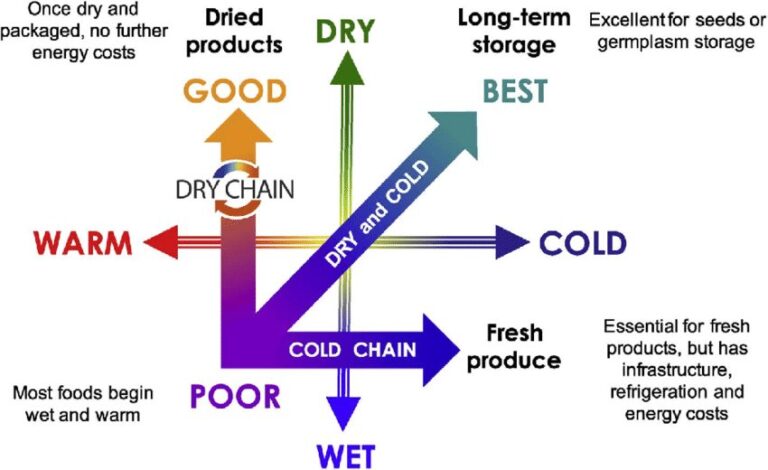
Correct Storage Requirements Of Commodities
The different types of commodities will require separate storage condition in order to maintain or improve their condition or quality. These commodities are split up into the general categories of meat, fish, fresh fruits and vegetables, dairy products, frozen foods, tinned foods, dry goods and cleaning materials.
- MEATS: All sides, quarters or whole carcasses of meat should be hung in cold room at a temperature of 0-1.c with a space between them to allow free circulation of air with drip trays placed underneath in order to collect any blood ( To avoid the formation of Rigor Mortis). According to the type of meat this period will vary from 2-10 days, permitting a chemical change to take place to produce more tender meat.
- Poultry and game – should be hung at a temperature of 0-1.c with the expectation of venison or hares and rabbits that should be hung at a temperature of 3-4.c.. Poultry should be stored on slated shelves at 0-1.c and game placed on metal trays at the same temperature.
- FISH: Wet fish should be stored in a separate, special type of refrigerator with perforated non-rust trays allowing the fish to drain and permitting easy cleaning of refrigerator. The fish should be placed on crushed ice on a wet cloth, covered with another cloth and crushed ice being stored at a temp. 1. c. Shellfish should be placed in boxes covered with a wet sack and crushed ice being stored at a temp of not lower than 3.c. Both wet fish and shellfish should be stored for minimum time.
- FRESH FRUITS AND VEGETABLES: All types of fresh fruits and vegetables need careful storage properly in a room where there is no sunlight. The room should be dry cool & well ventilated with bins for root vegetables. Fruits and vegetables deteriorate quickly and space should therefore be available to enable easy stock rotation. Soft fruits and melon should be refrigerated at 4-5c.
- DAIRY PRODUCTS: Most dairy products with the exception of cheeses should be stored in a refrigerator or cold room at a temp. 0-4.c. Milk should be stored in a container in which it is delivered and kept covered because it will absorb strong smell. Butter and eggs also absorbs smells, especially those of fish, onions and cheese. Cheese should be stored in a cool place which is dry and well ventilated. Because of its strong smell cheese should be kept away from other items, if whole cheese is to be stored for a period of time they should be rotated occasionally.
- FROZEN FOODS: There is a great variety of frozen foods in either an uncooked or cooked state and these should be stored at a temp of at least -15.c to -18c. The lower the temperature of freezer means food can be kept for a longer time. All foods should be kept frozen until needed but time must be allowed for defrosting before issuing. Foods should be kept on plastic coated trays in upright deep freezers and in plastic type baskets in the chest type of deep freezer.
- TINNED FOODS: It should be stored in a dry, well-ventilated store to prevent them from rusting. Blown tins caused by gases should be discarded or returned to supplier as oxidation have taken place either bacteria or tin plating being attacked by the food. Dented tins should be used immediately before they rust.
- DRY GOODS: are sugar, flour pulses, preserved foods such as jams, pickles, dried fruits, tea, coffee etc. the conditions of storage for the same is dry, cool and well ventilated. They could be kept in bins with the lids on. Some dry goods require airtight lids e.g. tea, coffee, etc.
- CLEANING MATERIALS: a separate store is necessary for all cleaning materials because of its strong smell and also the possibility of confusion/mistakes being made in their.
STORAGE AREAS:
- DRY STORAGE: Dry storage should be adequately ventilated with sufficient air circulation and desired humidity. It is advisable to keep non-food items away from the food supplies. Food items should be kept away from the walls, floors and ceilings. There should be proper utilization of space. Proper labeling of shelves should be done in order to have an easy issuing process. The temp maintained should be between 40 – 75.f. there should be traffic control for free movement of carts etc.
- REFRIGERATED STORAGE:
- There should be an automatic mechanism to alert off the staff to any refrigerator failure. The efficiency of the refrigeration depends upon factors like- type of refrigerator, type of compressor, extent of insulation, capacity of the storage area, amount of food and its arrangements in the storage area.
- For energy conservation opening and closing of the door should be controlled.
- Plastic strip curtains are very valuable in conserving energy.
- There should be automatic temperature recording device.
- Keep the area clean to void moisture.
- Defrosting should be done regularly.
- The cooked food should be kept away from the raw food and hot food should not be kept directly rather it should be kept in a wide container so that it can get cooled fast.
FROZEN STORAGE: It is walk in freezer opening into walk in refrigerators. The temp maintained should be between 0-20.c. Small individual packages should be made in order to avoid thawing of whole lot. Individual quick frozen items e.g. fish. Advantage of packing fish by this method is that it does not stick to each other. It is not advisable to refreeze thawed items since appearance, nutritive value may be affected. FIFO system is followed. The rotation of food items to be controlled by the use of meat tags. Freezer burns occurs when fat under the surface becomes rancid there by causing a brown discoloration or patches. Automatic signaling of freezer failure is highly desirable in large scale operation. Best utilization of space is must